so this might be a bit late tonight, but I will do my best to make it come as early as possible. This week has been even more chaotic than usual.
I hope you all managed to nip along to our convention. I did hear from some of you, but if you would like to share your best buy of the day scan or photograph it and send it along. You do not have to publish your name, you can use a pseudonym, or you can just be "A Wills Collector" or whatever the subject or card depicts. I look forward to hearing from you all.
So this week was a bit slow and it is hard to concentrate when you are being called away every five minutes. But every diary day in this newsletter has somehow filled with something and that is a miracle. The descriptions may be a bit sparse but we have a "what`s new" box to inform you of any changes we make on the site so you will not miss anything we do.
And this week we take a journey through the sense of smell, meet a relaxed rabbit, hear about the story of Staffordshire, fly on an all too brief comet, sing with Bing, gaze at greenery, and finally meet Alice Jeanne Leppert.
Onwards, and upwards, we go!
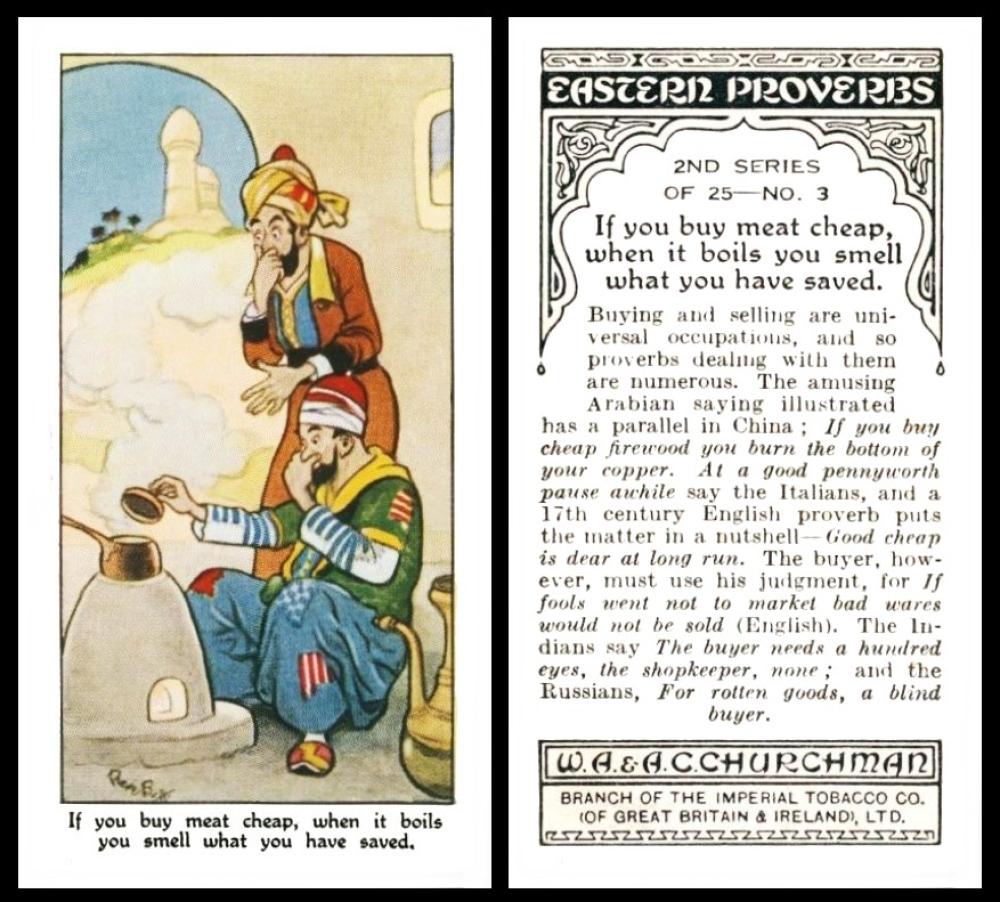
W.A. & A.C. Churchman [tobacco : UK] “Eastern Proverbs” 2nd series (August 1932) 3/25 – C504-470.A.2 : C82-44.A.2 : C/41 (RB.10/40) : Ha.521
For today`s "National Sense of Smell Day" we have gone for the pungent over the perfumed.
As to why, well smell is a clever sense for it tells you when something is good, and when something might harm you. The best way to tell if food is off is indeed to smell it. And if you recoil it is probably not good to eat.
It is not a perfect test, because sometimes there may not be enough odour to smell, but you could still be affected. And it also depends on the person who is sniffing, for not everyone can detect smells perfectly, or at all. If you cannot smell, it is called Anosmia, and it can be caused by exposure to chemicals, damage to the nose, or even before you are born.
This is the second series in the standard size. In fact there were not only two sets of that standard size but there were four sets each of twelve large sized cards.
Our original Churchman reference book RB.10, from 1948, describes our second series as :
41. Aug.1932. 25. EASTERN PROVERBS. Inscribed “2nd Series of 25” Other detail as (40) but different subjects.
As I have not added a (40) in yet, those details are
40. Aug.1931. 25. EASTERN PROVERBS. (titled series) Size 2 11/16 x 1 7/16 or 67 x 36 m/m. Numbered 1-25. Fronts printed by letterpress, 4-colour half tone process. Backs in dark green, with descriptions. Printed by Mardon, Son & Hall. Also issued in New Zealand by Ardath Tobacco Co. Ltd.
(when I show a 40 this will move to there and a link will be inserted)
Ha. 521 simply lists the fact that there is an Ardath version (small cards “A series of 25) and adds the two small and four large sets along with the total number in each set.
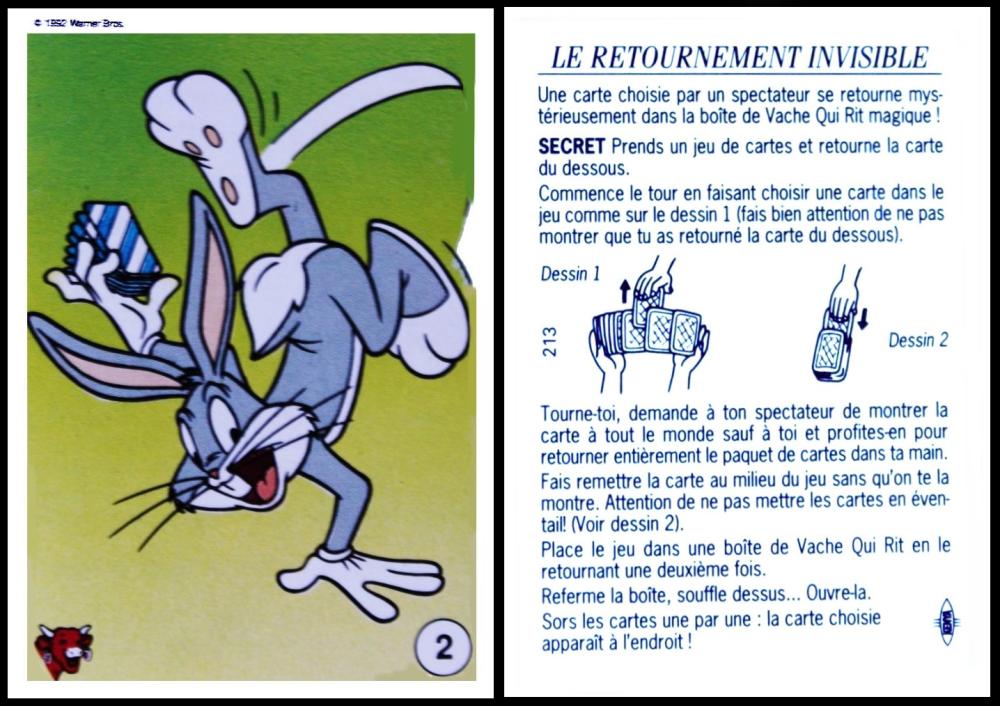
La Vache Qui Rit [trade : cheese : O/S : France) "Tour de Magie" (1992) 2/?
Believe it or not, today is National Bugs Bunny Day. This is celebrated every year on April 30, because on that day in 1938 Bugs Bunny was born, at least to the general public, he had spent some time before that on a drawing board.
Actually he appeared in a slightly different form first, in a short subject called "Porky`s Hare Hunt" starring Porky Pig.
His first appearance as Bugs Bunny was in 1940, in a film called "A Wild Hare", and his voice was supplied by Mel Blanc. He appeared in over a hundred and fifty short films from 1940 until 1964, and all these films were hand drawn, there was no computer animation then. He was drawn on to a thin sheet of cellophane, known as a cel, and then slightly differently positioned on another, and so on, until when each was replaced in turn and filmed the figure appeared to move.
From such small beginnings he rose to have a star on the Hollywood Walk of Fame and also become the symbol of Warner Brothers.
Now La Vache Qui Rit means "the cow who laughs", or more grammatically, "The Laughing Cow". It has been retailed since 1921 and is sold in many different formats, but the most popular seems to be the triangles, which are similar to Dairylea. However Dairylea triangles only date from 1950, so perhaps we should be saying Dairylea`s are similar to these..
Not sure how many cards there are in this set, so over to you.
The backs of these cards show magic tricks, hence the title of the set, for in French "Tour de Magie" means "Trick of Magic".
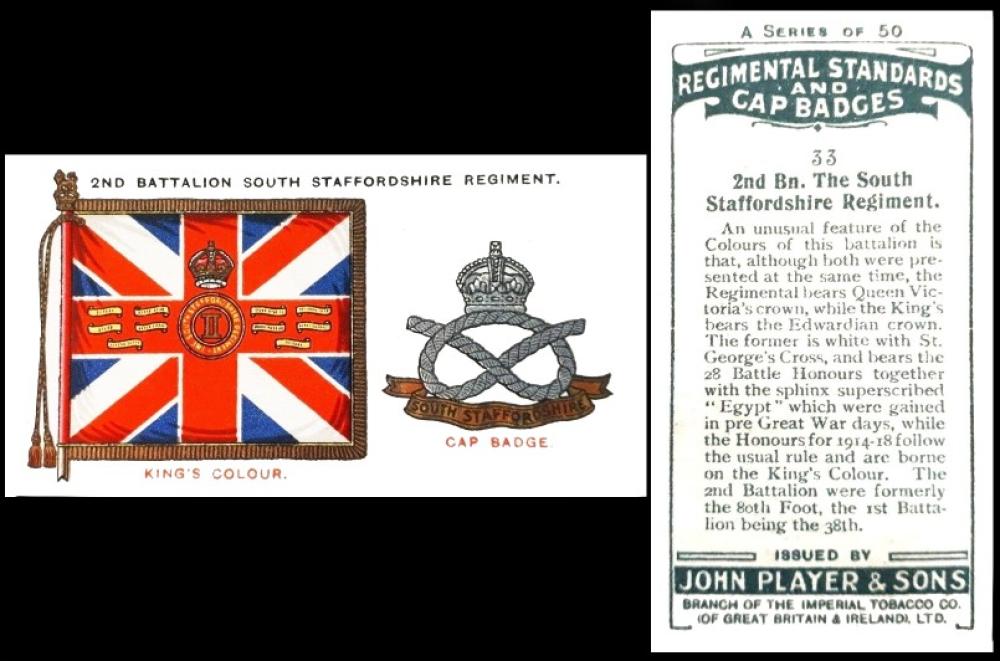
The code to this will be added later but
Today is the County Day for Staffordshire. Reportedly this pays tribute to Josiah Wedgwood, whose pottery company was set up in 1759, and that made Staffordshire not only famous but forever called the home of the Potteries.
Our card has a more military connection for it celebrates the Second Battalion of the South Staffordshire Regiment. Now at the time this card was issued there was no idea of what they would eventually get involved with, piloting gliders, and landing at Arnhem, to mention just two.
The site that you reach with that link ends when they stopped being part of the Paras. But in 1945 they were sent over to Norway, and then they were moved to Germany, which was split into East and West in 1949. By then our group had been merged with the First Battalion, and they went to Hong Kong, and Northern Ireland, returning briefly to Germany and then in 1955 they were off to Cyprus.
Four years later they were gone, merged in to The Staffordshire Regiment (The Prince of Wales`) along with another survivor The North Staffordshire Regiment, from whom they retained the Royal title.
Bit more about this set tomorrow as well

today in 1952 the first jet liner flight with fare paying passengers took off from London heading to Jersey. This aircraft was the DeHavilland D.H.106. However the so called "Comet 1" prototype first flew over Hatfield on Sir Geoffrey DeHavilland`s sixty-seventh birthday, the 27th July 1949. It was also the birthday of the Test Pilot.
This card was issued in 1953, which saw three Comets breaking up in the air. Two were ruled as structural failures, which was later found to be due to metal fatigue. The other was caused by the weather, which pushed the frame beyond its operational limits.
The company changed the specs and made it both larger and stronger, perhaps they had to make it larger in order to reinforce the frame. They also changed the shape of the windows, which must have been thought to be the weak link, and they were, because technically it was a hole in the fuselage. Any craft that were still waiting for the results were modified but new aircraft were also made from scratch.
However the public were not so keen to use them and after many surveys it was decided not to relaunch as a passenger craft at that time but to transfer them to the Royal Air Force and let them be used as troop transport and training.
In the meantime our advantage was lost and American aeroplanes were zooming away with the passenger trade and also being sold worldwide to airlines.
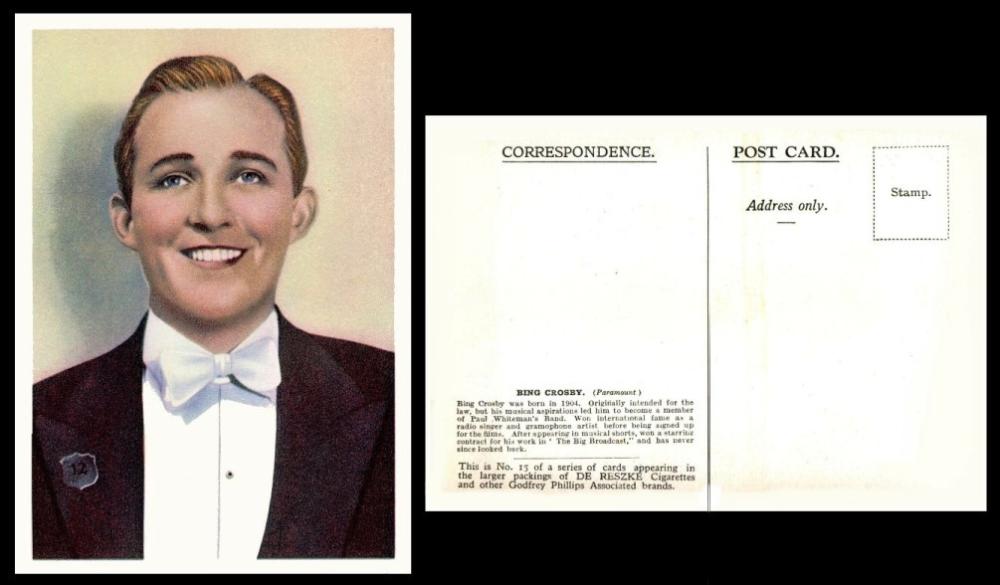
Godfrey Phillips [tobacco : UK] “Film Stars” (untitled) series three postcard size (1936) 15/24 – P521-446 : P50-109 : RB.113/74-76
Here we have Harry Lillis Crosby, Junior. He was born today in 1903, in Tacoma, Washington, one of seven children. He studied law originally but did not enjoy it. What he did enjoy was playing music, and he soon found several bands to allow him to both play the drums and sing. He also made a record, quite late on, he was already twenty-seven, and this somehow landed on the desk of the head of CBS. He liked it and sent for Harry Crosby, and this led to him performing live from New York over the radio for about three months straight. That was in 1932.
Because of this he was asked if he would like to appear on screen, in a film called "The Big Broadcast". That was released in 1932 and featured many cameos of film and radio performers. His mellow style gave him the nickname of The Crooner. He had the nickname "Bing" as a child but there are so many conflicting tales of its origination that we will probably never know the truth.
He moved easily from this cameo into another singing part, with Fred Astaire in "Holiday Inn". In fact this was the first screen performance of the song White Christmas. However he did not only sing, or play in musicals. He also enjoyed comedy, and was teamed to great effect with Bob Hope in the series of travelogue/adventures which became known as "The Road" films. And he won an Academy Award for playing a kindly priest in "Going My Way", released in 1944. It also won the award for Best Picture. However though he was nominated for the follow up the next year he lost out to Ray Milland, in "The Lost Weekend", which, curiously, also won the Best Picture award.
In the 1960s and 1970s Bing Crosby also appeared on television, which moved at a faster pace than the movies but which he found very exciting.
He died, whilst playing golf, in Spain, on October 14th, 1977. He was seventy-four.
According to the Trading Card Database / Bing Crosby he appears on almost three hundred cards. The earliest cards were issued some time between 1930 and 1939, and all are trade. The first cigarette card that carries his portrait is Gallaher "Champions of Screen and Stage" which was issued in 1934. They also cite our card as being issued the same year, but it was not, for although the first series was issued that year, our card is from the third version and that was issued in 1936.
Our original Godfrey Phillips reference book (RB.13), issued in 1949 tells us there are three series of these cards. The full description is :
FILM STARS – Home issues. Fronts printed by photogravure in colour. Backs in black, with descriptive text. The series was issued in two sizes :-
73. Small cards, size 67 x 35 m/m. Series of 50. Cards entitled “Film Stars”. Home and export issue 1934.
74-76. Post Card size 128 x 89 m/m. No series title appears on the cards. Issued 1934-6 –
74.
A. Nos. 1/24. (1st Series, A) “This is No. … of a series of 24 cards…”. Backs in postcard format. Home issue 1934
B. Nos. 1/24. (1st Series, B) “This is No. … of a series of 24 cards…”. Postcard printing OMITTED from backs. Home and export issue 1934
75.
Nos. 1/24. (2nd Series) “This is No. … of a series of cards…”. Backs in postcard format. Home issue 1935
76.
A. Nos. 1/24. (3rd Series, A) “This is No. … of a series of 24 cards…”. Backs in postcard format. Home issue 1936
B. Nos. 1/24. (3rd Series, B) “This is No. … of a series of 24 cards…”. Postcard printing OMITTED from backs. Home and export issue 1936
Some of the cards in series 74 and 75 are based on the same originals as cards in 73 but there are a number of new studies, Cards in 76 represent an entirely different series, the colouring and particularly the background being more vivid.
By the time of our original World Tobacco Issues Index the small sized cards had been moved and this section only deals with the postcard sized ones.
1. Series of 24. Nd. 1/24. Back “This is No. … of a series of 24 cards…”. Back (a) with (b) without postcard format
2. Series of 24. Nd. 25/48. Back “This is No. … of a series of cards…”. Back in postcard format
3. Series of 24. Nd. 1/24. Vivid backgrounds to front. See Ha.517-3. Back “This is No. … of a series of cards…”. Back (a) with (b) without postcard format
Our updated World Tobacco Issues Index has a surprise for series two had been discovered with a non-postcard back. Therefore the (a) and (b) now come in the header above the series listing so it reads that all sets are found with a postcard back or without .

Ching [tobacco : UK] “Around & About in Jersey” second series (1964) 23/24 – C440-100.2
Today is National Greenery Day, in Japan, but the idea is a good one for it is stated to be a day to appreciate the natural world and to give thanks for it by having a ceremonial cup at a tea room.
Now we may not all have a tea room, or want to be that formal. That is up to you. But do take some time to sit and look at nature and to wonder at it. And also to have your first cup of the day, whether it be tea or coffee, whilst looking out of the window. Or take a flask to your local park.
If you are a coffee drinker, why not try tea, just for once. There are different health benefits to each - coffee is a stimulant, and can help guard against cancer, diabetes, and brain disorders like Alzheimers and dementia, plus it also contains fibre for bowel health. Whilst tea calms the blood pressure (which coffee probably does not), lowers cholesterol, soothes stress, especially if you sip slowly. And there is enough caffeine to have a smaller, but still an effect, on the health of your brain.
Now this card features Howard Davis Park, where, coincidentally, there is a tea rooms.
The park is named after the son of Thomas Leopold Davis, a fisherman and ship's carpenter, whose life at sea included his surviving a journey where his ship ran aground and he not only found a rowing boat but rowed it to safety.
Howard Davis, the son, started out following his father on to the ocean wave. But his ship docked in Scotland on the eve of the First World War and he decided, on the spur of the moment, to enlist in the Army. The recruiting office in the town was for the Highland Light Infantry, and during the first day of the Battle of the Somme his troop went over the top. He was wounded and died of those wounds six weeks later.
In 1937 his father bought a house and grounds with the intention of leaving it as a memorial. He did not want the house, so that was demolished, and the rest was turned into the park we can visit today if we live nearby. Fittingly the grounds now also include a Commonwealth War Graves cemetery.
This set is not in the original World Tobacco Issues Index, because that was published in 1956 and Ching did not start to produce cards until 1959. However our updated issue from the year 2000 tells us that it is :
AROUND AND ABOUT IN JERSEY. Md. 77 x 64.
1. First 24 subjects, back in black. Nd. (24)
2. “Second Series”, back in green. Nd. 1/24

R. J. Lea [tobacco : UK] “Girls from the Shows” (1935) 19/48 – L250-850.B : L26-35.B
Closing up tonight`s entertainment we have pretty and bubbly Alice Faye. She was born today in 1915, in New York, and christened Alice Jeanne Leppert.
She started young in show business, and was a chorus girl; however when she auditioned for another theatre she was discovered to be under age so she lost both jobs.
By the time she was sixteen she was on Broadway, and in 1931 she was playing in the George White Scandals, the 1934 film version of which are mentioned on our card. However she did not get this, her first film part, because they remembered her on stage. At the time she was also appearing on the radio, as part of Rudy Vallee`s Show, which was sponsored by Fleischmann`s Yeast. Rudy Vallee was in the film version, and when Lilian Harvey rather abruptly left he suggested that Faye be brought in to replace her.
This kick started her career and in the 1930s through to the 1940s she appeared in many musicals, but also serious films too. She was especially good in "In Old Chicago" the story of the fire of 1871, which was one of the highest costing productions at the time and for some years after.
She returned to radio towards the end of her career. Her first marriage fell apart when the couple were too busy to spend any time together, and in 1941 she married the popular bandleader Phil Harris. He also appears on cards, which you can see at the Trading Card Database / Philip Harris - and even better she appears with him on one. He was heavily involved with radio so she thought it would be a good way to spend even more time together. Her voice was great for radio, it was bubbly and very expressive. They were married for fifty-four years, until he died. She outlived him by just three years and their ashes lie beside each other in the mausoleum in Forest Lawn
Our original World Tobacco Issues Index tells us that this set was
GIRLS FROM THE SHOWS. Black and white. Nd. (48). Special album issued.
A) Small. 67 x 35. Matt halftones
B) Small. 66 x 34. Glossy photos
Both were issued the same year. Any theories as to why the two versions? I can only think that the matt set was for a cheaper brand.
This week's Cards of the Day...
have been celebrating The Centenary of the Football Association Cup Final at Wembley Stadium, on April the 28th, 1923. However it might be a hundred years on from when the Final was first staged there, but it did not start there, and between 2001 and 2006, whilst the original Wembley Stadium was replaced by a more modern building, the final was transferred to the Millennium stadium in Cardiff.
The first ever "Football Association Challenge Cup Final" was played in 1872 at the Kennington Oval, which we now associate with cricket, but also saw the first ever England Football International, played against Scotland. The first Cup Final took place on the 16th of March 1872, Wanderers vs Royal Engineers. The result was 1-0 to Wanderers.
Now this is not Wolverhampton Wanderers but a team that is no more. They came from Leytonstone and were actually Forest F.C. but because they had no set ground they were jokingly called the Wanderers, and in 1864, just a year after being founded, they decided to adopt that name formally. They were pretty good players for all that, though, because they won five of these Finals. It seems odd, then, that they were no more by 1887.
The Royal Engineers was, as you probably suspect, a military team. They were founded in 1863 not to take part in sporting contests but simply as a good and enjoyable way of playing a game whilst installing comradeship and teamwork in the ordinary ranks, and they were actually responsible for bringing in a more structured game, where the ball was not just booted up and down the ground, but skilfully passed to a member of the same team.
The F.A. Cup Final itself moved the very next year, because the Wanderers had no home ground to move to. It ended up at Lillie Bridge, in Fulham. Then it returned to the Oval, though it did briefly move in the 1885 season when there was a no-score draw between Blackburn Rovers and West Bromwich Albion - the rematch was at the Racecourse, which was another cricket ground, the home of Derbyshire County. And why it was called that was because it was inside Derby Racecourse! In 1893 it moved in a northernly direction, to Manchester, and then the following year to Liverpool. In the case of draws, or no-score draws, the precedent remained, and they were held at a different venue. Then it returned to London, and was held at Crystal Palace until the start of the First World War.
It resumed in 1919, but at Stamford Bridge, and it stayed there until Wembley was opened in 1923.
Today that first Wembley Cup Final is known as the White Horse Final. The reason why, well, it was almost as disaster, because it was massively over attended, This could have been checked because it was well known that the capacity of the stadium was known to be 125,000, but London Underground sold almost twice as many train tickets as that on the day, and the buses were filled to capacity with people squeezed along the aisles. But many people cycled, or walked, which could not be expected, nor tallied into the final attendance numbers. Many did not have tickets to the match, they were just going on the off chance.
It is estimated that two to three hundred thousand people managed to get inside the grounds, and many more failed at attempts to scale the walls by any means they could find.
The gates opened at 11.30 and it was full by 1 pm, even though the kick off was not until 3 pm. The stadium became so crowded that the spectators spilled over on to the edge of the ground and then on to the pitch, so much so that the kick off had to be delayed by forty-five minutes. There were approximately a thousand injuries reported. In fact there were thoughts that the game might have to be cancelled, but the police, including P. C. George Scorey and his gallant white horse Billie, were able to push the spectators back, and then more police to keep them at bay by patrolling throughout the match. However the players had difficulty getting through the crowds at half time and it was decided they should remain on the pitch.
Bolton Wanderers won two nil. Their first goal was scored by David Jack and the second by Jack Smith, though this was a bit controversial as it went in and then bounced out, but the referee said it was valid.
the 1923 final was famous for being known as the white horse final after the white horse named billy cleared the playing area after the crowd spilled onto it and an estimated 127,000 were inside the stadium i doubt an exact figure is known.the f.a.cup had been played on numerous grounds until in 1895 it was housed at crystal palace until the outbreak of the 1st world war.then after the great war it was played at chelsea's stamford bridge ground till the 1922 final then when wembley opened it was played from 1923 onwards bolton wanderers v west ham united was the 1923 final and the bolton striker david jack was made famous as the 1st player to score a goal at wembley stadium.the final score was 2-0 to bolton jack also scored the winning goal for bolton in the 1927 1-0 victory over manchester city in total bolton won the fa cup 3 times in the 1920s and once more in 1957.but the final will be forever remembered for the white horse.
Saturday, 22nd April 2023
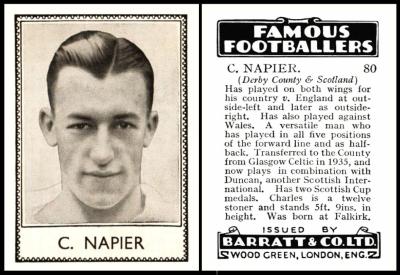
So your first clue to this week`s theme was the team shown here, Derby County, for they were defeated in the first semi final, going down 5 - 2 to West Ham United, who, in many ways, were seen as the most likely winners of the cup.
That semi final was on the 24th of March 1923, and it was at Stamford Bridge, the home of Chelsea Football Club. There was a reason for this not being played at Wembley, because the stadium was only completed that day.
The match was a thriller, with amazing performances from West Ham`s William Brown and Billy Moore, who each scored two goals. The other one came from James Ruffell.
Derby County had a more sedate time. Jimmy Moore was their only goal scorer. Their other actually came from West Ham full back Billy Henderson, an own goal.
Our subject is later than all this. He was Charles Edward "Charlie" Napier, and he was born on the 9th of October 1910. He started at Celtic, where he was on the squad that won the Scottish Cup in 1931 and 1933. Then he moved over the border and down to Derby County, where he is on our card. He had moved to Sheffield Wednesday when war broke out. He kept playing, with Falkirk, but the leagues were all suspended, these matches were just for entertainment and morale boosting. After the war he stayed in Scotland, with Stenhousemuir. He also had a spell with the Scottish National Team. He died in 1973.
Now this card has been sent to us by a reader, so many thanks for taking the time and trouble to do so. It is quite a scarce one from a set which is usually regarded as Set C, and which is described in our original British Trade Index as : "FAMOUS FOOTBALLERS 1937 - 38 issue. Sepia. Numbered. (110)". This is slightly altered in our our updated version to include the size, 62 x 44 m/m, and cites HB-35.C (which I will look at tomorrow)
Sunday, 23rd April 2023
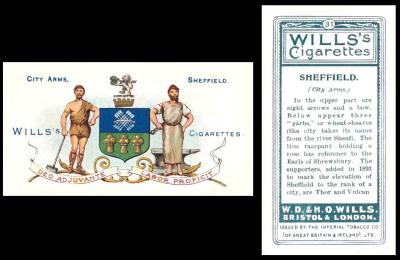
So here we have clue number two, the answer to which was the town of Sheffield, for the other defeated semi finalist in the 1923 Run Up to the Cup Final
This match was played the same day as the other semi-final, 24 March 1923, but it was played at Old Trafford, the Manchester United Ground. However it was not such an exciting match, Bolton Wanderers winning by a single goal.
This card is just one of the variations of this fascinating set, which are dealt with more fully in our blog "B for Borough Arms". That tells the differences in all the sets, and one day will include a sample back and front of every one.
This particular card we feature today is from Group 3 - Numbered set of 50, 1-50, these being removed from the fronts and placed on the backs. Oddly, the numbering system is entirely different on every card. Fronts printed in full colour, no frame lines, with "Wills`s Cigarettes" across fronts of cards. Now although the pictures on the cards of this group are identical to those of group 1,the back is entirely different, for the design has gone and a descriptive text about the picture has replaced it on the back. And those backs are printed slightly darker, in blackish grey.
Monday, 24th April 2023
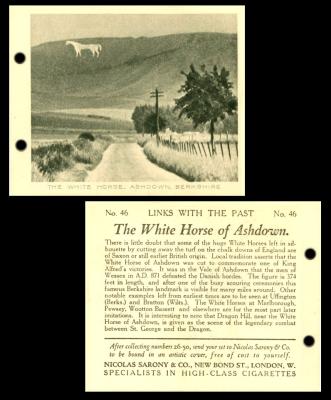
So here we have a white horse, and that should have been the link that gave you all the theme of the 1923 F.A. Cup Final, because a white horse, called Billie, was involved in crowd control at the final.
For his efforts, the rider, P.C. George Storey was given a free ticket for life to every future F.A. Cup Final. He never took any - but reportedly every year lots of people wrote to the Football Association claiming to be him, and asking for their free ticket, which means that the offer must have been made public in some way. As to why he never attended, he said he was not fond of football.
I have not found out how the horse was rewarded, but I hope it was well.
Our original World Tobacco Issues Index lists this as
Sm & Lg. Grey-black gravures. Special artistic covers issued for binding sets through holes punched in left hand corner.
1. First 25 subjects. Nd. 1/25. Home issue.
A) Sm 71 x 42B) Lg 78 x 63
2. Second 25 subjects. Sm.69 x 40 Lg. 78 x 63
A) Advertisement issue. Lg without holes punched. Back in blue with advertisement for set and Sarony Cigarettes. Handouts. Unissued.B) Home issue. Nd. 26/50. Back in black. Size a) small b) large
C) Sydney & Melbourne issue. Nd. 1/25. Backs in blue. Size a) small b) large
D) Christchurch (New Zealand) issue. Nd. 1/25. Back in blue. Size a) small b) large
Now there are a number of questions here which perhaps you can answer.
The first is what are the binders like? On the back of this card there is a bit more information about them, which reads: "After collecting numbers 26-50, send your set to Nicolas Sarony & Co. to be bound in an artistic cover, free of cost to yourself". I presume that the first series say the same apart from the numbers?
Next question is about the advertisement issue. Was this just the one card with one picture or was it a whole set with different backs? How was it handed out? And why does it say "unissued"?
Finally, let us move down under. And ask how do we know that the overseas ones were issued in Sydney/Melbourne and Christchurch? Do they have a local address? Also confusing is the fact that the numbers are 1/25 but the sets are listed under the second series. So are the pictures the same as our set, rather than being from Australia and New Zealand? I suspect they are, or it would have been under a different group. With that in mind I am not sure how interesting these cards would have been to smokers there though, being links to a past they did not share.
Tuesday, 25th April 2023

So here, in the distance, is Wembley Stadium, home of the F.A. Cup Final, and this is almost certainly a card that football fans know nothing of. In fact there are two others in the set, but all are glimpses. There is a description on one though. This makes it even odder that there was not a front, even that front, showing the Stadium.
Anyway our original Churchman Reference Book (RB.10) says :
151. 1922-23. 25 Wembley Exhibition (titled series). Size 2 11/16 x 1 7/16" or 67 x 36 m/m. Numbered 1-25. Fronts in gravure, in brown. Backs in brown, with description. Printed by Mardon, Son and Hall.
That date is definitely incorrect for many reasons.
In 1922 the stadium, and the buildings for the exhibition, were nowhere near this complete.
1923 would have been concievable, and useful, if it was pre-advertising, after all the postal franks advertising the exhibition did start in 1923, but the cards would need to show the exhibition before it opened, whilst here we have people in the streets, and the Railodok transportation system in use, not being tested. Most telling is that whilst the stadium was opened in 1923, just four days before the Cup Final, many of the people who got in without tickets used the ladders and scaffolding from the pavilions which were still under construction. And these pavilions are finished. In addition if we look back at our card, the building on the left is the South African Pavilion, and the foundation stone for that was laid by General Smuts, and it appeared in the Gaumont Graphic newsreel in October 1923, which must have been fairly contemporary to that event taking place. Whilst the other building, on the right, is Malta, which seems to have been a bit ponderous as to whether it wanted to take part, the building`s plans not being drawn up until late 1923 and most of the exhibits only arriving two weeks before the opening of the exhibition. However it was one of the most popular pavilions, which makes it even stranger that they did not return in 1925.
That brings us to 1924, the year that the exhibition opened (23rd of April 1924), and also a really wet year, and it is definitely raining on this card.
On the reverse of our card, the text is entirely devoted to modes of transport at Wembley, in fact the text says "Once inside one has wider choice of transportation than any Exhibition has ever offered". Cited were the Railodok Car, the Never Stop Railway (which worked by means of a screwed track that varied in size to make the railway carriages merely slow down as they got to and through the stations, and even "the ubiquitous Bath Chair, with its well informed attendant."
It is not until card 8 that the stadium is mentioned. That card is : "A General View. In this picture the Stadium towers can be seen in the distance. Once through the high walls which form the Exhibition Facade, its immensity is immediately apparent, It will hold 125,000 spectators on the terraces and stands, and altogether covers a space of more than 10 acres, and is one of the largest sports arena in the world". This is a bit of a curiosity for it seems to ignore the overcrowding of the F.A. Cup Final of 1923, which could support it being issued before that date, but it is the only card that could. Perhaps it is more likely that they were thinking of the events which were to be held in the Stadium throughout the Exhibition, which would almost certainly not suffer the same.
You can also see the stadium on card 9 "Palestine". I will scan these three in some time! Maybe even by Saturday but no guarantees.
On card 16 we have no sight of the Stadium, but we do have another clue to the date because that is for "The Palace of Industry" and it mentions "The Palace of Engineering, opposite". However for the 1925 season the Palace of Engineering was renamed to The Palace of Housing and Transport.
Our original World Tobacco Issues Index simply describes this set as "Sm. Brown gravure. Nd. (25)", However the updated version adds new information, that being that there are two versions, according to the depth of the frame on the back, which is either (A) 59 m/m or (B) just over 60 m/m. I have not checked my set yet to see if I have a marriage, but I will tomorrow. Though it will take all my concentration to work that tiny difference out!
Wednesday, 26th April 2023
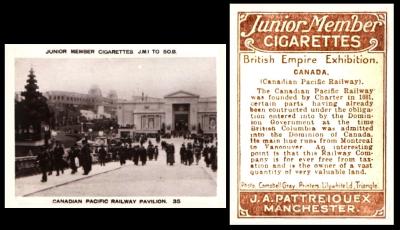
Now here we have another view of the Stadium.
This card seems to have no firm date either, though from the cards it is clear that at least some of the pictures were taken in late 1923 or early 1924, definitely before the Exhibition opened, for they show the buildings surrounded by workmen`s tools. Curiously the coloured set of cards, which are identical to these, have had all that paraphernalia removed from view by skilful retouching.
This shot must have been taken after the exhibition opened in 1924, for it shows crowds.
Our original World Tobacco Issues Index files this set under section 1. 1920s Photographic Series, which is further described as being "Fronts black and white ... medium size 75-80 x 57-58 m/m" - and then under sub section 1B. Numbered Series. It says the set is : "J.M.1 to 50.B. Titled "British Empire Exhibition" on back with descriptive text. Md. (50)"
Thursday, 27th April 2023
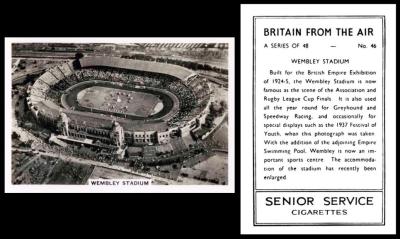
This is another view of the Stadium, which is no longer just a part of the Wembley Exhibition, most of which was either dismantled and shipped off to other exhibitions, or sold off at a grand auction.
This card does mention the Exhibition, and also that it is now used for Rugby, Greyhound (from December 1927), and Speedway racing (from May 1929), as well as telling us that the Empire Swimming Pool has been added, (that was built for the 1934 British Empire Games, and last used for the 1948 Olympics) and the accommodation enlarged (probably for the same reason - for these British Empire Games, the forerunner of the Commonwealth Games, saw five hundred athletes taking part in sixty-eight events).
Oddly I cannot find anything about the Rugby League Cup Final. Maybe they mean the Rugby Challenge Cup? That started in 1896 and the first final held at Wembley was in 1929, Wigan v Dewsbury. Wigan won 13-2
This photo is not of a football or a rugby match, it was taken during the 1937 Festival of Youth. Which seems a while ago, as the card was not issued until 1939.
Our original World Tobacco Issues Index lists this under section 3. That covers the 1930s Photographic Series. This set is described as: "Britain From The Air. Md. (48) “Senior Service” brand issue. Two printings."
The updated version adds a bit more about these different printings. They involve either the size of the card, or the caption panel, or the depth of the framelines. This seems rather vague, so if there is a specialist who can show us rather than describe them I would be most grateful. Thanks in advance.
Friday, 28th April 2023
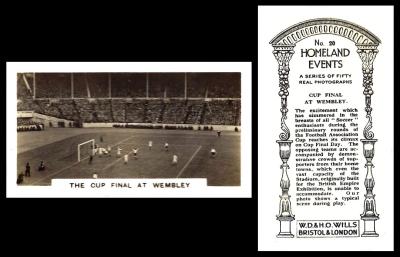
Cup Final at Wembley – but which one? If you know do tell us!
This set was issued in New Zealand, Malaya, Malta, and what our original World Tobacco Issues Index rather cryptically calls “elsewhere”, and it is catalogued under New Zealand issues as "HOMELAND EVENTS. Sm. Black and white photos. Nd. (50) See W/233.A
However our Wills booklets state that there are two sets of Homeland Events. These are :
232. 54. Series of 54. Size 63 x 35 m/m. Wills` name and I.T.C. Clause at base of back, Home issue 1932.
233. 50. Series of 50. Size 66 x 36 m/m. Issued between 1925-30. Similar series issued by Lambert & Butler.
A) Wills` name at base of back, no I.T.C. Clause. Issued in New Zealand.
B) Anonymous backs. General Overseas Issue.
The home issue with 54 cards dates from February 1932, whilst the New Zealand one is quite a bit earlier, arriving in August 1927.
It looks like the anonymous series of 50, issued through British American Tobacco was hot on its heels in 1928.
The Lambert & Butler set of 50 was also issued in 1928, but only overseas. This is mentioned in our original reference book RB.9 where it is described as :
53. 50. HOMELAND EVENTS. Size 2 19/32 x 1 3/8 or 66 x 35 m/m. Fronts : uncoloured photo prints. Backs in black, with descriptions. Export issue.
well we did get there, and look, not too late, though buster is wondering why I still have the light on in here at almost midnight when he wants to go to sleep. I might turn in too, for a few moments before I get up and have a coffee, or the million other things I fill my sleepless nights with.
Good night to you all, and thanks for popping by, whoever you are
